Best drum machines 2025: for every style and budget
From drum synths to samplers - expert advice on the best beat makers from Roland, Elektron, Teenage Engineering and more
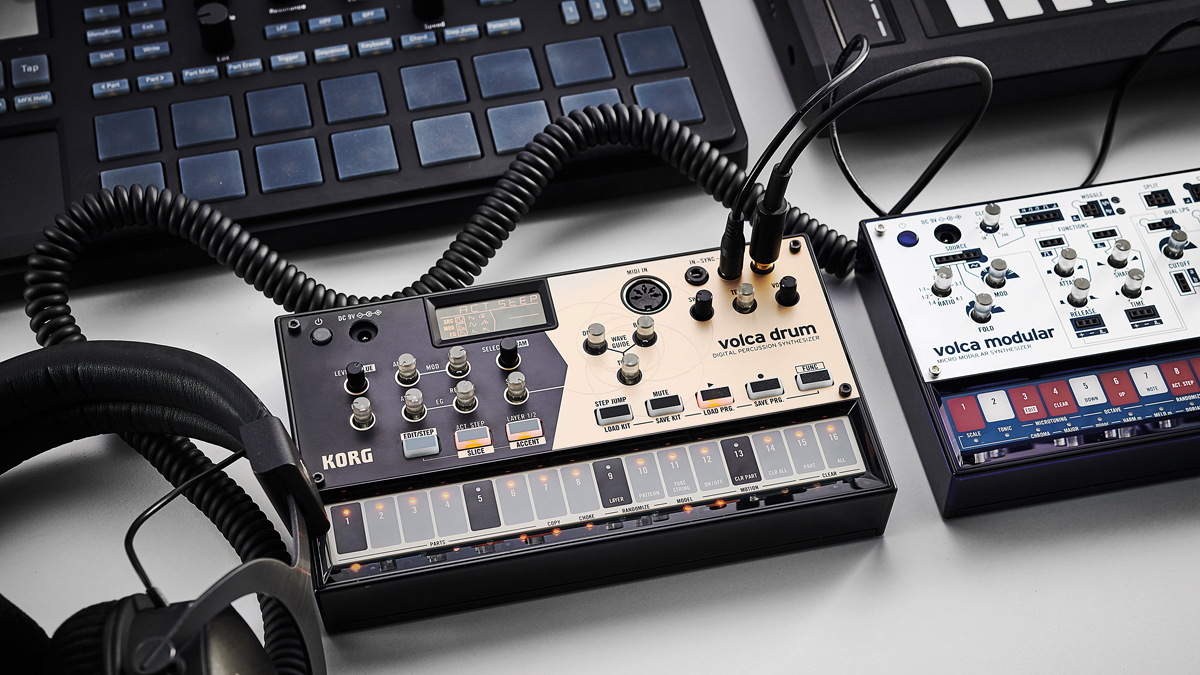
Let’s be honest, in 2024 the easiest and most flexible approach to beat-making is in-the-box. DAW tools such as Logic’s Drum Machine Designer, Ableton’s Drum Racks or the similar beat making tools in FL Studio, Reason or Bitwig are immensely powerful, allowing users to quickly sequence sampled and synthesised tones side by side, with endless editing and processing possibilities.
So why on earth would we advocate using a hardware drum machine? As is the case with hardware synths, there’s something very unique and creative about working with a self-contained machine. While DAW tools tend to offer open-ended functionality, the best drum machines will lend themselves to a certain sound and way of working through their selection of sounds, sequencing workflow and hands-on controls. What’s more, there’s an inherent physicality to rhythmic creativity, and a good drum machine lets us lean into that, whether that’s through bashing out patterns using performance pads or sketching rhythms using a physical sequencer.
Hardware drum machines have made something of a comeback over the past few years, due to a wider resurgence in the popularity of electronic music production hardware, and because falling prices have made buying a cheap drum machine almost as budget-friendly an option as purchasing a software plugin.
What’s more, it’s not only software beat tools that have become significantly more advanced in recent years. Compared to vintage instruments, modern drum machines generally offer a host of tools to help you creatively use hardware and software side-by-side.
Each of the best drum machines in this guide will function as a standalone instrument, so you won’t need to hook these up to a laptop to begin beatmaking. We’ve tried to cover all the bases here, from budget beat boxes that deliver reliable, bread-and-butter sounds to fully-fledged grooveboxes that can integrate melodies, samples and effects with their drum patterns.
We’ve opted not to include larger music production workstations in this roundup, such as the Akai MPC Live II, Native Instruments Maschine, Polyend Tracker+ and Ableton Push. Although they’re great for beat-making, these machines are more like hardware DAWs aimed at producing complete tracks.
The quick list
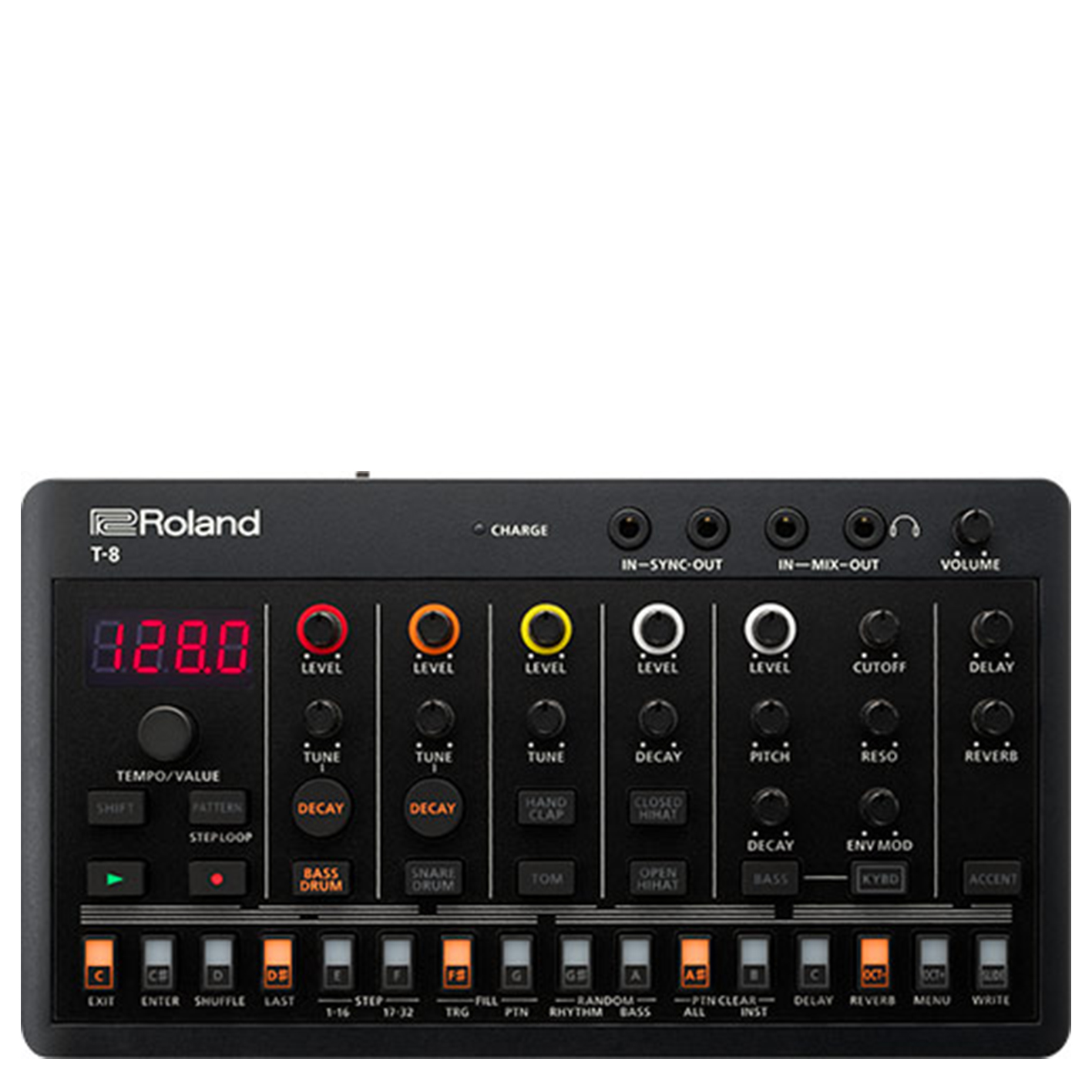
The emulation-meets-samples TR-8S is still the company’s strongest offering – and arguably the best all-round drum machine on the market right now – but we think the recent Aira Compact T-8 also stands out for its pocket-sized convenience and bargain price.
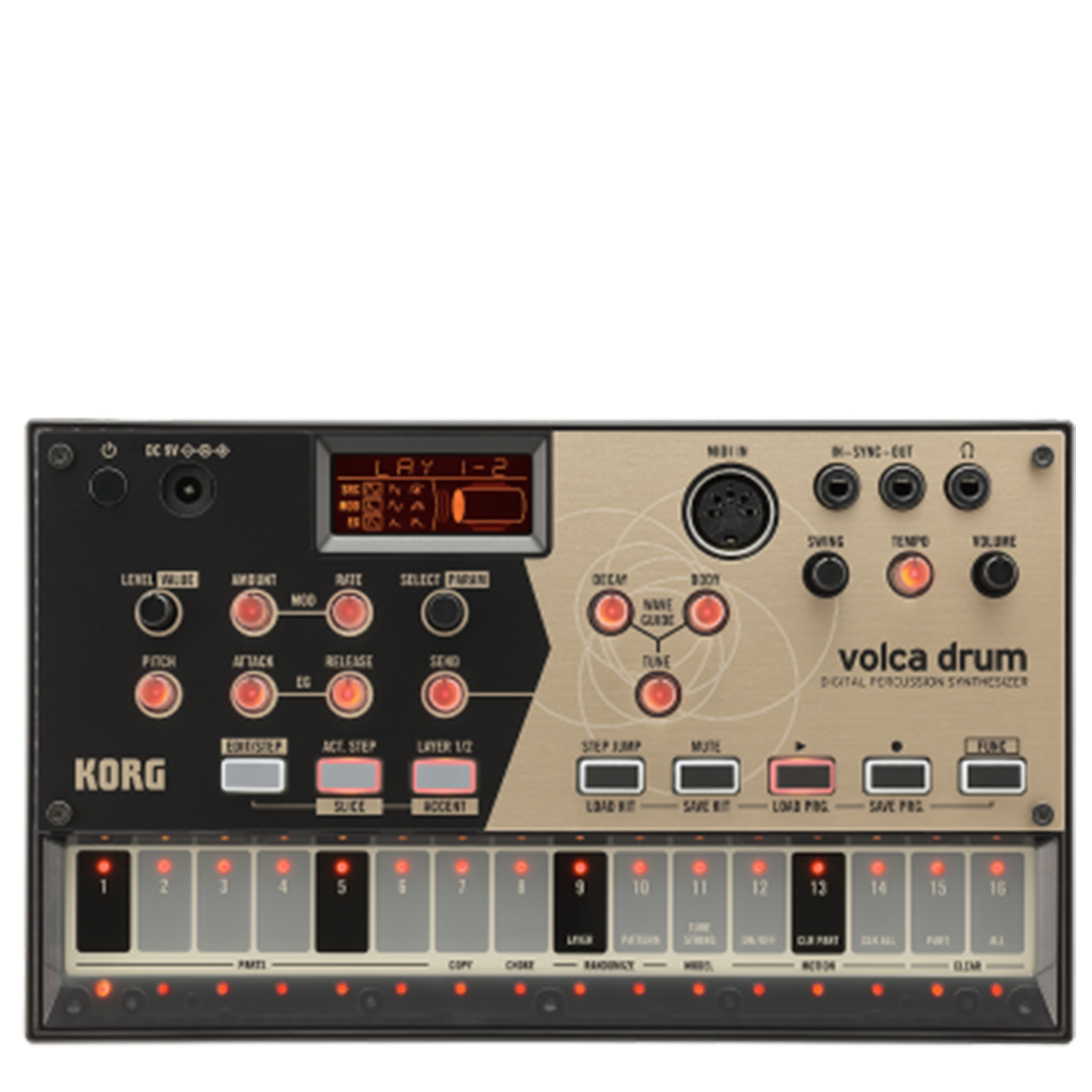
While the other Volca beatmakers, Volca Beats and Kick, both condensed analogue drum synths into the range’s compact hardware format (and the company's Volca Sample lets you add your own beats), the Drum uses digital synthesis to create a percussive palette that’s broader, and weirder, than its predecessors.
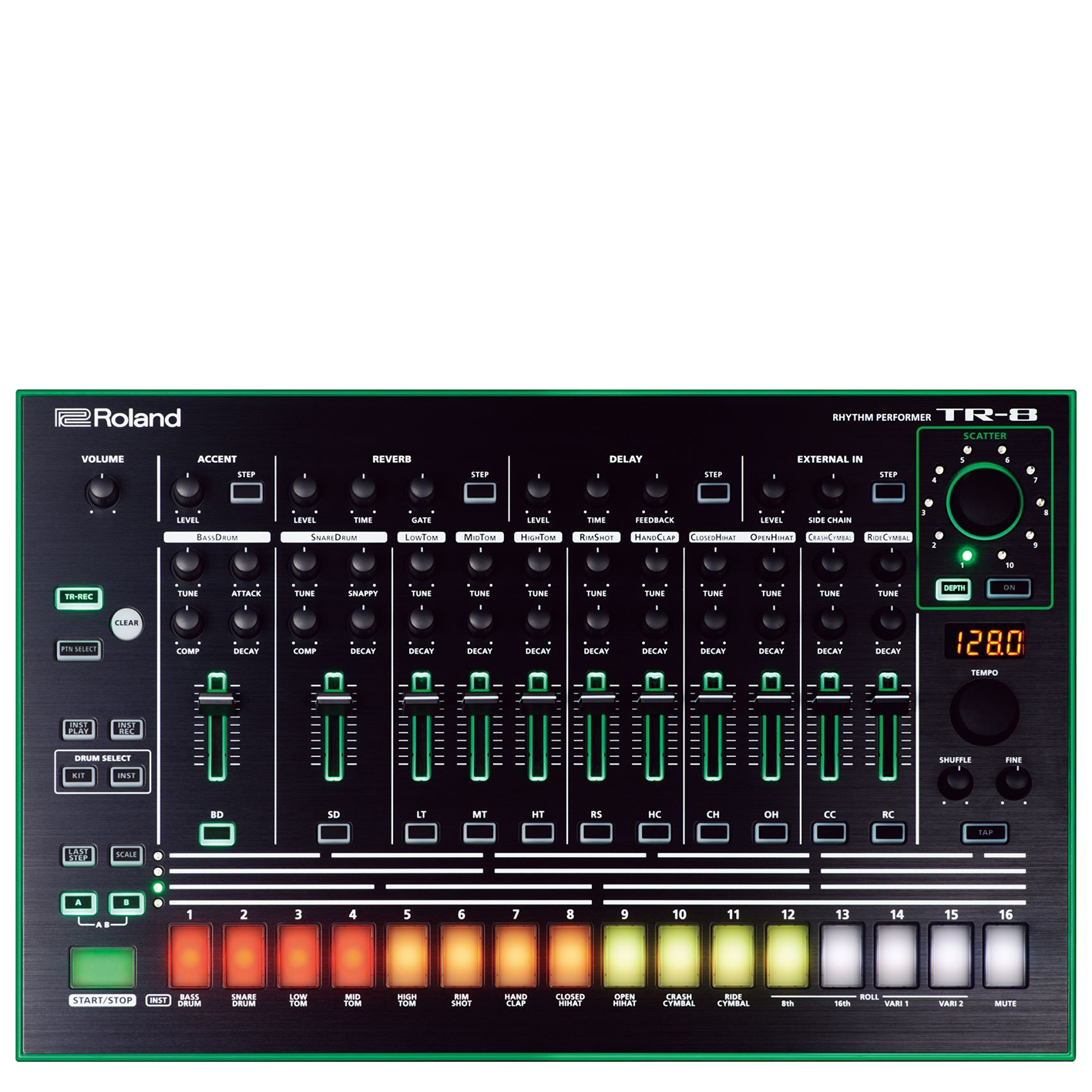
On the whole, we found the TR-8S to be excellent. It builds on the potential of the original in all the right ways: it's a machine that’s far more flexible but still intuitive and, most importantly, a lot of fun to use. Its popularity has led to a long lifecycle of updates too, including the addition of FM synthesis sounds and, most recently, a new way to play the tuned bass drum like a melodic bass part.
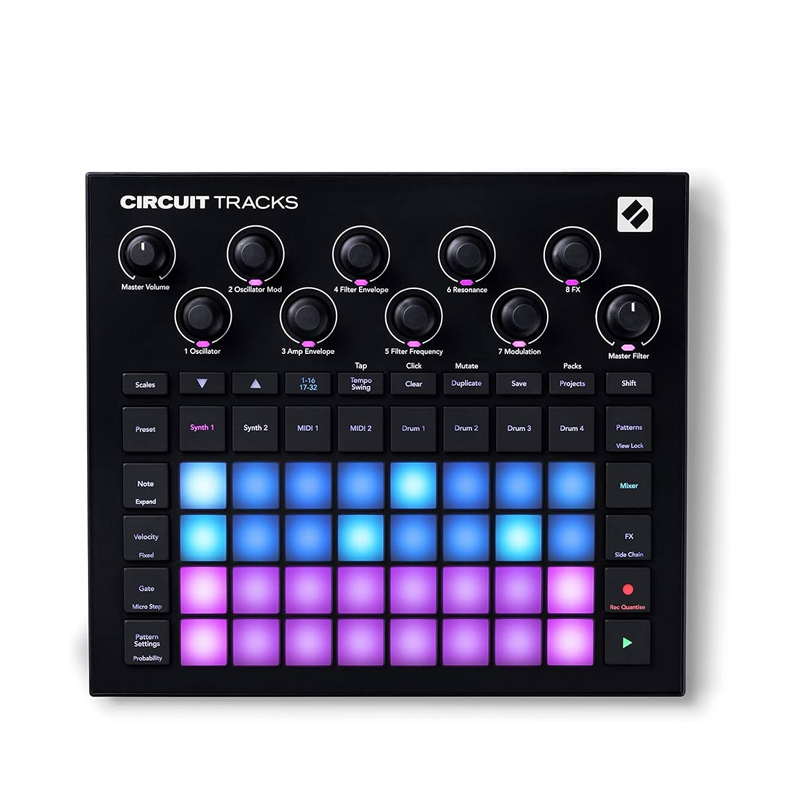
Back in 2015 when Novation released the original Circuit, we were immediately impressed. For a battery-powered instrument priced at just £250, this digital groovebox was remarkably well-equipped, boasting two independent polysynths, a four-track sampled drum machine, send effects and a nifty step-sequencing workflow. It’s a credit to Novation that, even given this strong starting point, Circuit has only improved since through a steady stream of firmware updates.
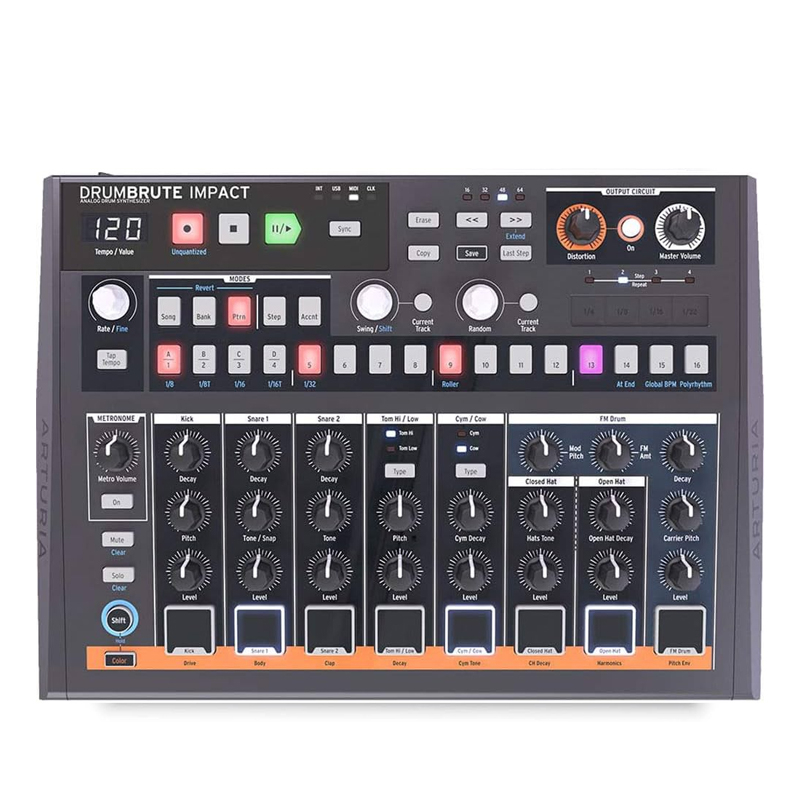
Although there are fewer different instruments – 10 instead of the DrumBrute’s 17 – the Impact is not simply a cutdown version of the larger machine. Much of the sound engine has been overhauled here, and the DrumBrute’s Parker and Steiner filter has been switched out for a beefy distortion effect. The pressure and velocity-sensitive pads are a bonus, and the sequencer Roller and Beat Repeat tools are a couple of handy options for spicing up fills and turnarounds.
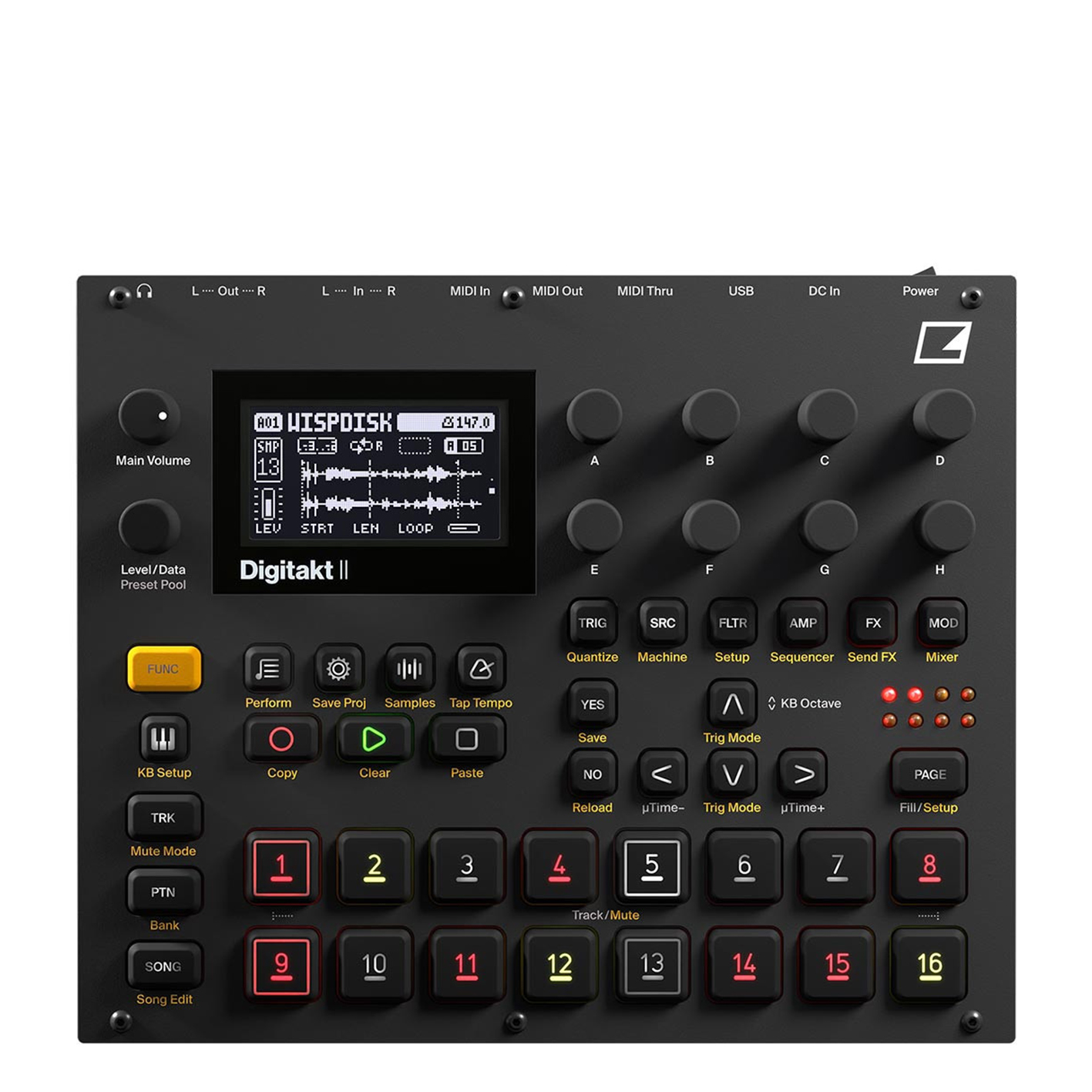
The original version of Elektron’s rugged sampler was already a popular choice for beatmakers, thanks in part to its ability to simultaneously sequence its internal sample engine and control external gear via MIDI. Digitakt II doubles down on what made the instrument popular – literally, in the sense that it doubles the original’s eight audio tracks to 16. It also adds stereo sample playback, which massively enhances its percussive sound design capabilities.
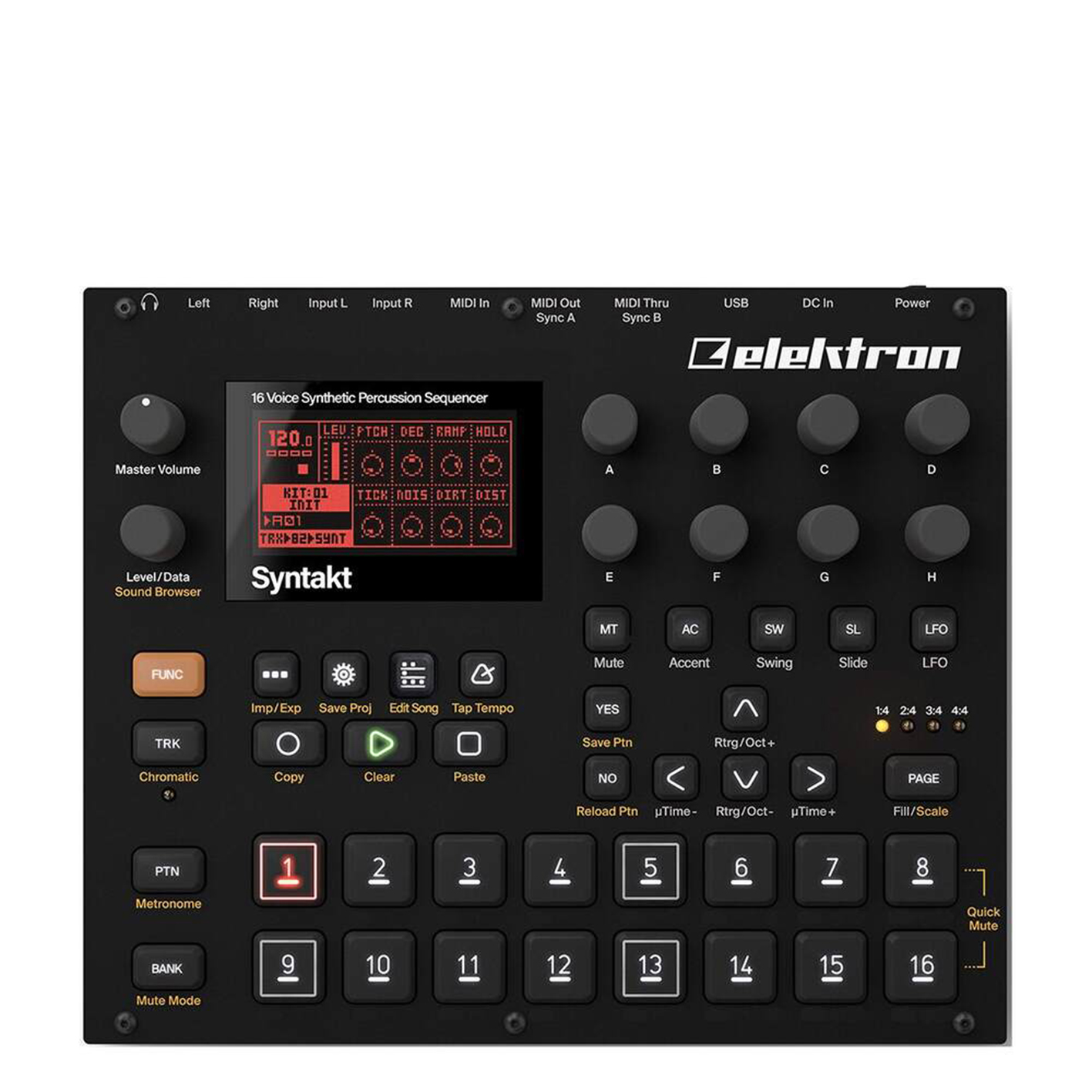
By combining two distinct synthesis approaches – classic analogue synthesis and digital FM synthesis – Syntakt offers a vastly broader palette of sounds than many traditional drum synths. Of course, this also comes equipped with one of Elektron’s distinctively deep, if occasionally unwieldy, sequencers, which is capable of deep automation programming, probability sequencing, polymetric patterns, micro-timings and much more.
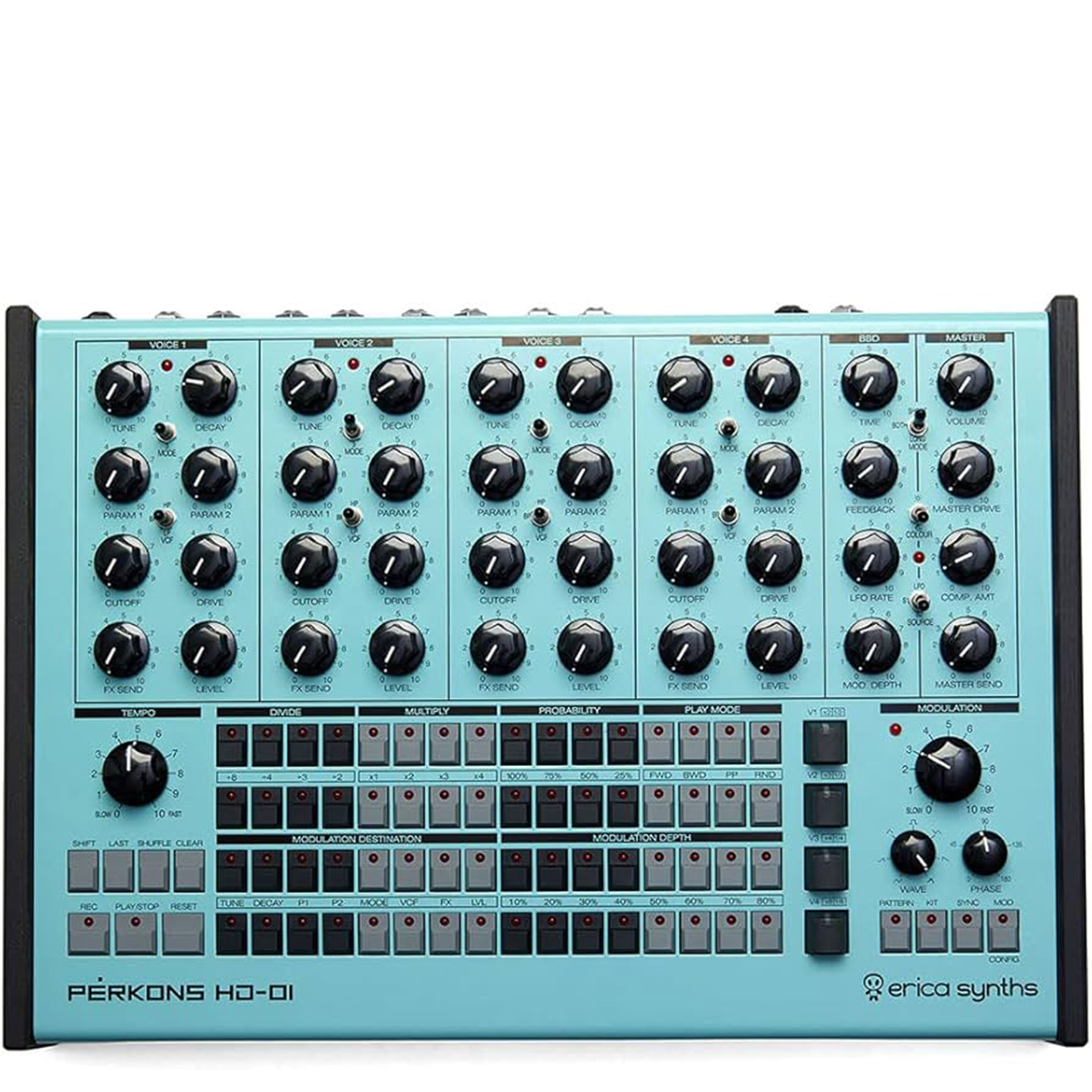
Perkons’ hybrid analogue/digital design functions as a best-of-both worlds approach, avoiding the flat tonality that sometimes comes with analogue drum machines, whilst maintaining the raw heft that comes with the best old-school machines. It does this by combining digital sound generators with analogue resonant filters and meaty overdrive for each voice.
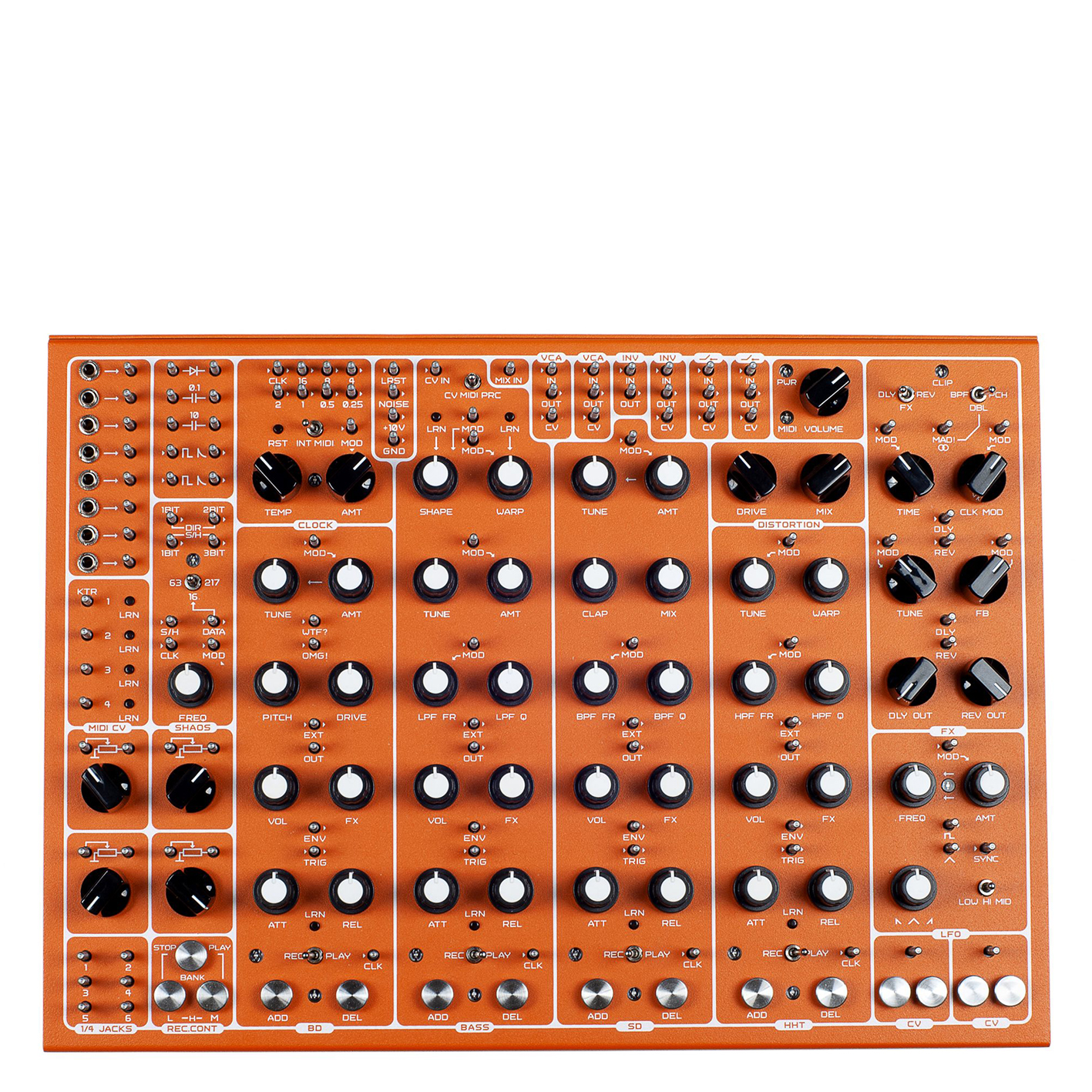
Unquestionably one of the most unique beat making tools of recent years. One of the most notable elements of the design is the extensive range of pins spread across the interface. These are patch points for re-routing the various sound elements and utilities, which can be done either using the supplied crocodile clips or by placing fingers across pins to let your body itself conduct signals – with more expressive, less predictable results.
Best for portability
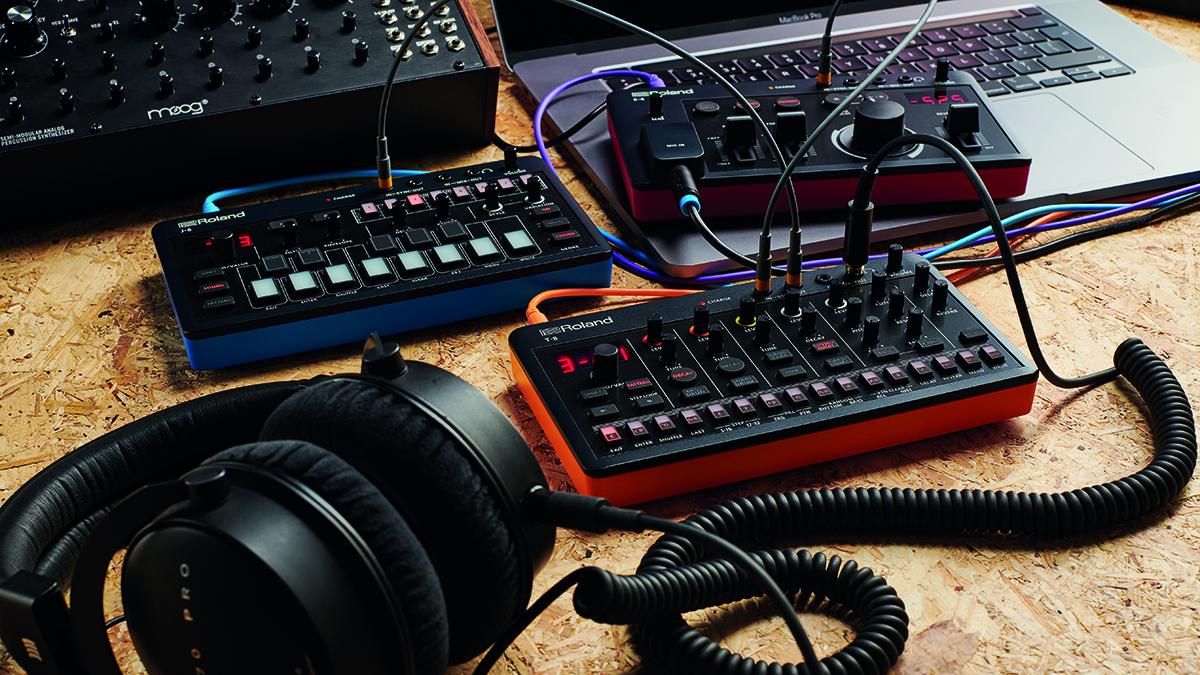
Specifications
Reasons to buy
Reasons to avoid
Roland has released no shortage or TR-inspired drum machines in recent years, from the original Aira TR-8 to Boutique emulations of the 808 and 909, along with various Cloud plugins. The emulation-meets-samples TR-8S is still the company’s strongest offering – and arguably the best all-round drum machine on the market right now – but we think the recent Aira Compact T-8 also stands out for its pocket-sized convenience and bargain price.
As well as offering emulations of those classic drum sounds, with full 808, 909 and 606 kits on board, the T-8 also benefits from a 303-inspired bass synth. Basically, if you’re in the market for vintage Roland groovebox sounds, you’d be hard pressed to find a cheaper and more convenient source in the hardware realm.
Read our full Roland T-8 Beat Machine review
Best sounds on a budget

Specifications
Reasons to buy
Reasons to avoid
While the other Volca beatmakers, Volca Beats and Kick, both condensed analogue drum synths into the range’s compact hardware format (and the company's Volca Sample lets you add your own beats), the Drum uses digital synthesis to create a percussive palette that’s broader, and weirder, than its predecessors.
Rather than use PCM samples, as many digital drum machines do, the Volca Drum’s sound engine uses a system of virtual analogue oscillators, modulators and resonators to create its percussive sounds. The sound engine has six parts, each of which is identical, and each part has two identical layers.
For designing sounds, this multi-layer engine is considerably deeper and more interesting than anything we’ve seen on a Volca beatmaker before, but above all else, it’s just nice to play with a drum machine that goes beyond aping the same old ’80s drum boxes. For dance music producers, this is a must-try.
Read our full Korg Volca Drum review
Best all-rounder
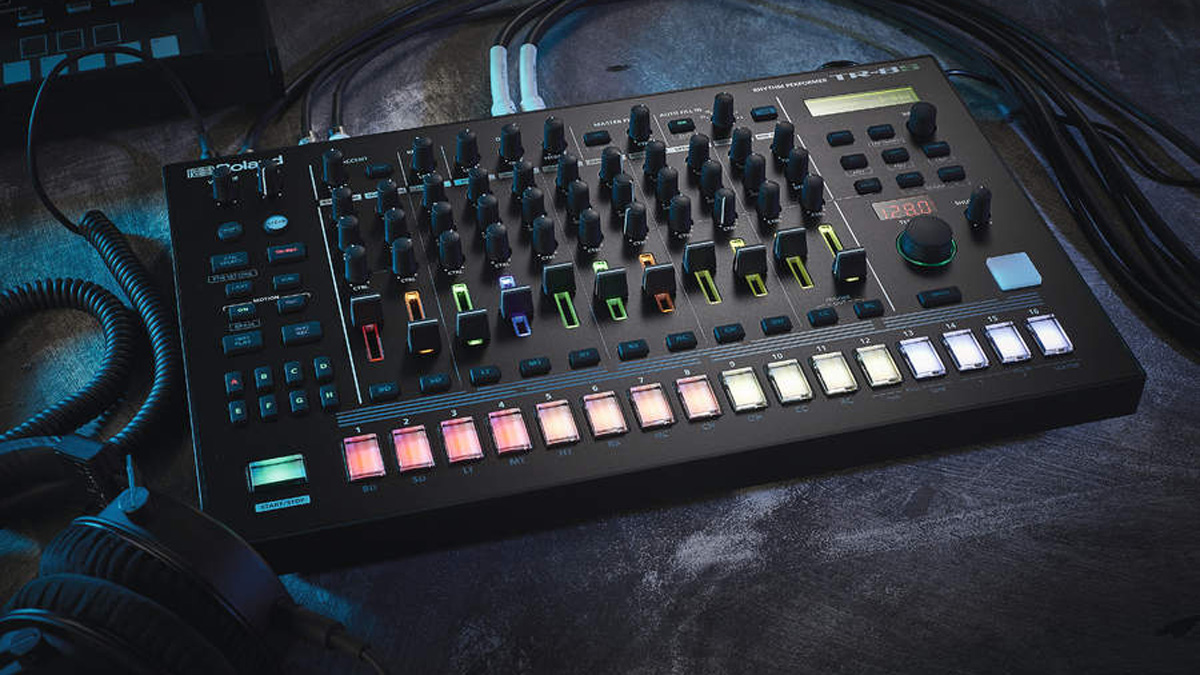
Specifications
Reasons to buy
Reasons to avoid
Part of the AIRA product family, Roland’s original TR-8 was built entirely around their Analogue Circuit Behaviour (ACB) tech, which emulates the circuitry of the original hardware units on a component-by-component basis. That same technology is still at the heart of the TR-8S, providing models of the 808, 909, 707, 727 and 606. This time around, though, these emulated instruments are joined by sample tracks.
Any of the TR-8S’s 11 instrument tracks can be assigned to either an emulation or a sample, meaning that, alongside the expected pure emulation kits, this drum machine comes equipped with plenty of interesting hybrid kits, with lots of scope for mixing and matching the two sound sources. Those core ACB tracks once again offer high-quality, largely convincing recreations of the original boxes they’re based on.
On the whole, we found the TR-8S to be excellent. It builds on the potential of the original in all the right ways: it's a machine that’s far more flexible but still intuitive and, most importantly, a lot of fun to use. Its popularity has led to a long lifecycle of updates too, including the addition of FM synthesis sounds and, most recently, a new way to play the tuned bass drum like a melodic bass part.
Read our full Roland TR-8S review
Best versatility
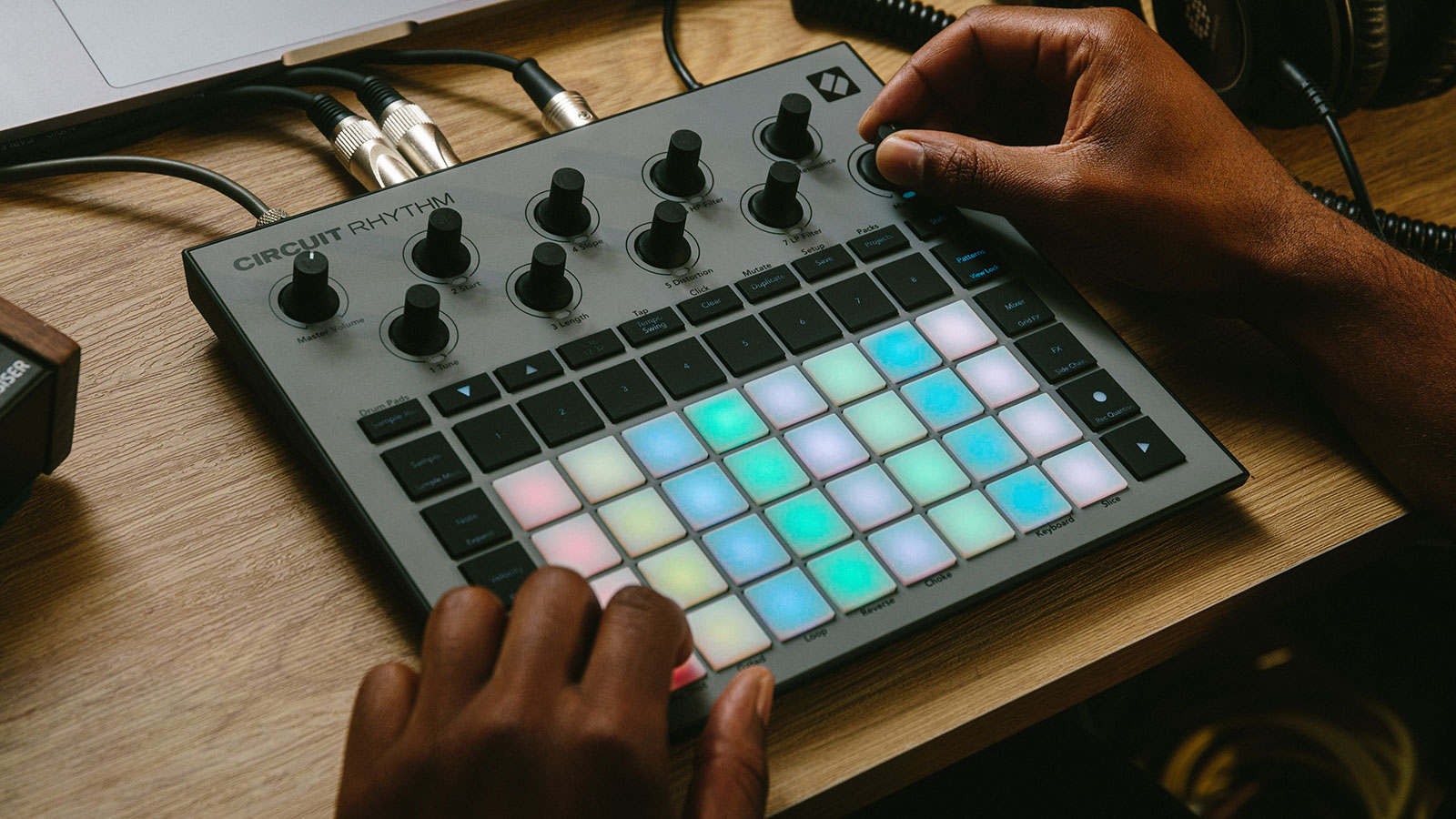
Specifications
Reasons to buy
Reasons to avoid
Back in 2015 when Novation released the original Circuit, we were immediately impressed. For a battery-powered instrument priced at just £250, this digital groovebox was remarkably well-equipped, boasting two independent polysynths, a four-track sampled drum machine, send effects and a nifty step-sequencing workflow. It’s a credit to Novation that, even given this strong starting point, Circuit has only improved since through a steady stream of firmware updates.
Now Novation has released Circuit Tracks, that despite the new name – which is intended to differentiate it from the underrated Circuit Mono Station and Circuit Rhythm – is a straight sequel to that original groovebox.
For the most part, the functionality of the original Circuit is carried over, meaning the synths and sampling capabilities are broadly similar to those on the original. The most significant additions are to the hardware. Tracks now features a built-in rechargeable battery and draws power using its USB input, while the onboard speaker has been removed. Extra connectivity includes a pair of audio input jacks and you get full-sized MIDI ports.
Add some sequencer improvements, extra presets, a new MicroSD card and deeper features like a synth editor and probability sequencing and Circuit Tracks has plenty to offer music makers at all levels. Whether as a convenient and portable tool to sequence a live setup, a portable synth and drum sketchpad or an all-round studio workhorse, Circuit Tracks has a lot going for it.
Read the full Novation Circuit Tracks review
Best all-analogue drum machine
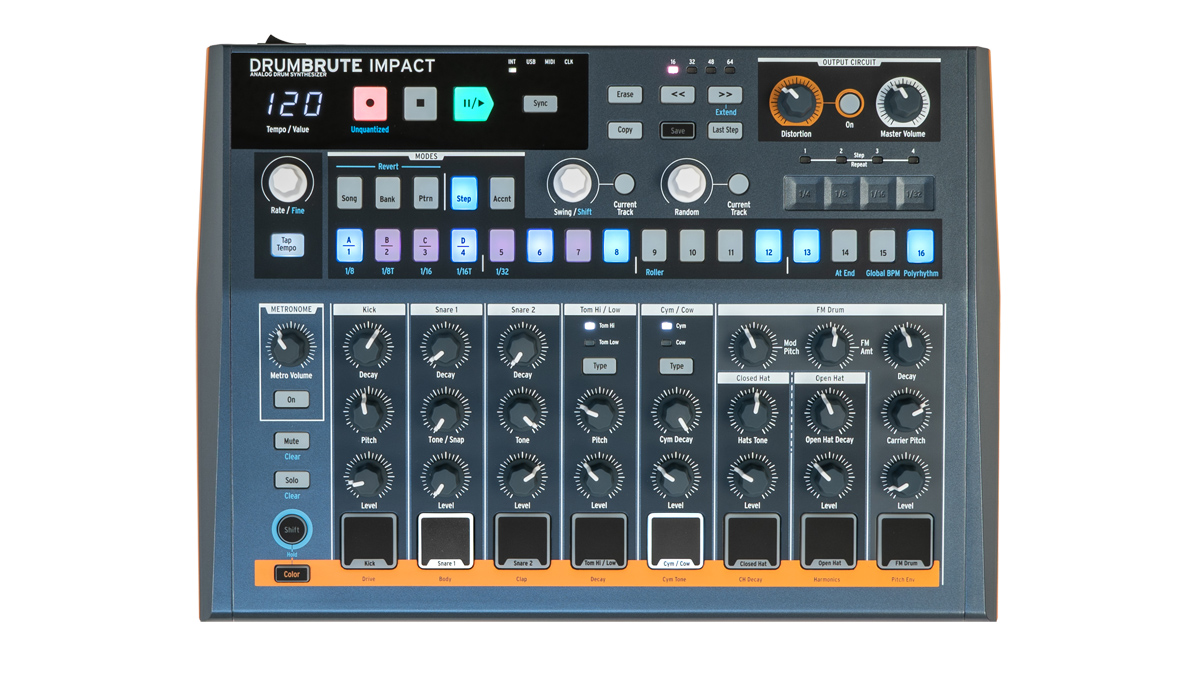
Specifications
Reasons to buy
Reasons to avoid
Like its bigger DrumBrute sibling, the Impact couples its sequencer with an all-analogue drum synthesis engine and very flexible pattern saving/song mode capabilities. Visually, the Impact looks pretty similar to its predecessor, housed in a solid, navy blue chassis familiar from the rest of Arturia’s ‘Brute range.
Although there are fewer different instruments – 10 instead of the DrumBrute’s 17 – the Impact is not simply a cutdown version of the larger machine. Much of the sound engine has been overhauled here, and the DrumBrute’s Parker and Steiner filter has been switched out for a beefy distortion effect. The pressure and velocity-sensitive pads are a bonus, and the sequencer Roller and Beat Repeat tools are a couple of handy options for spicing up fills and turnarounds.
The ample crop of 64 pattern slots means there are plenty of space to save and recall grooves, and the Song mode means these can easily be stitched together into full arrangements. While the Impact lacks a little sonic flexibility and isn’t all-round perfect, it is an inspiring and enticing drum machine at a very good price.
Read our full Arturia DrumBrute Impact review
Best for sampled beats
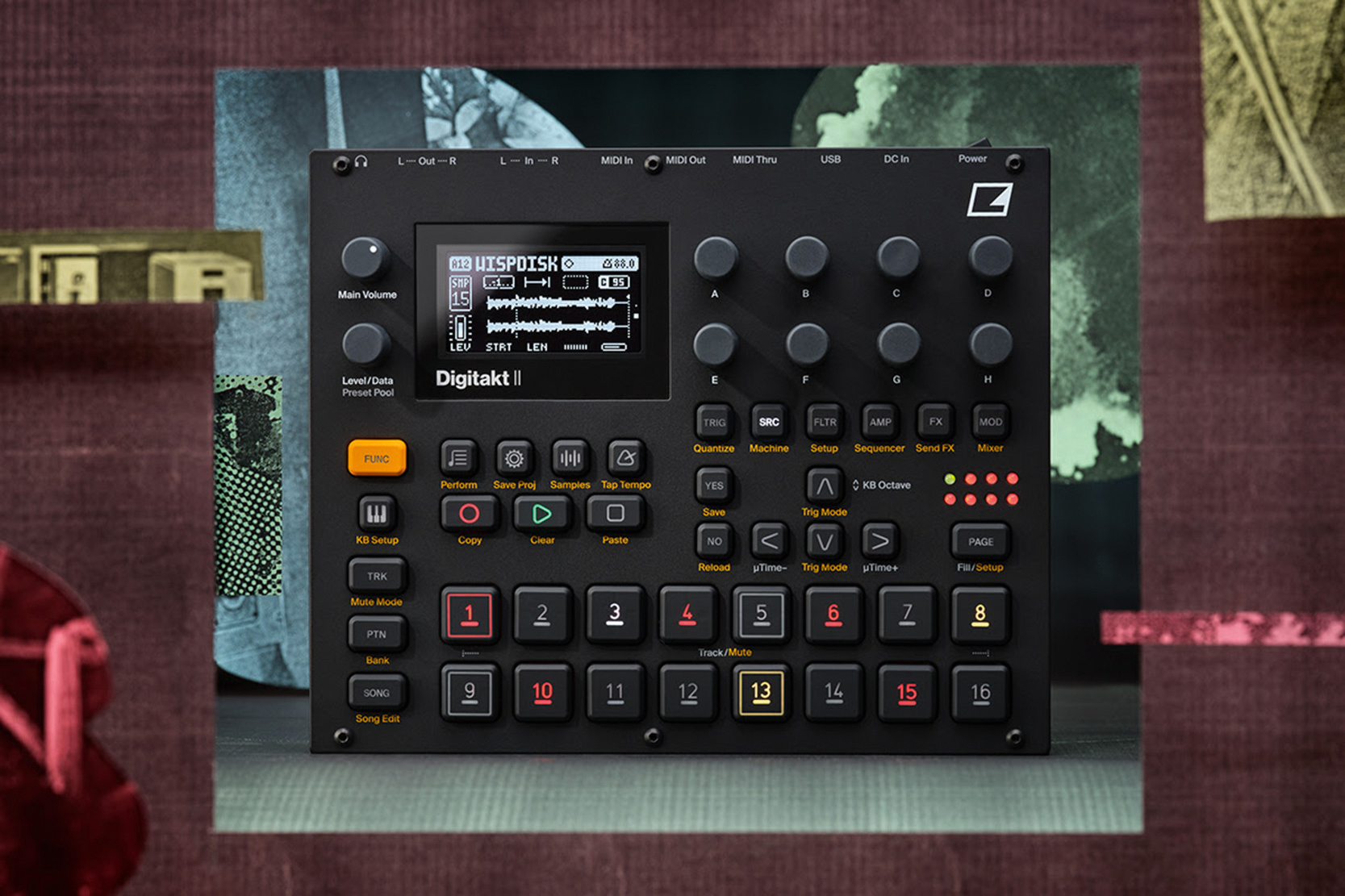
6. Elektron Digitakt II
Our expert review:
Specifications
Reasons to buy
Reasons to avoid
The original version of Elektron’s rugged sampler was already a popular choice for beatmakers, thanks in part to its ability to simultaneously sequence its internal sample engine and control external gear via MIDI. Digitakt II doubles down on what made the instrument popular – literally, in the sense that it doubles the original’s eight audio tracks to 16. It also adds stereo sample playback, which massively enhances its percussive sound design capabilities.
For our money though, the best enhancements for version II come in the form of the upgraded filters and LFOs. Additional comb and EQ filter modes add new sound shaping possibilities, and an extra LFO-per track makes it easier to keep your beats moving.
Further additions include a Euclidean sequencing mode, which adds an additional polyrhythmic flavour to the sequencing workflow, and new digital distortion modes.
Best drum synth
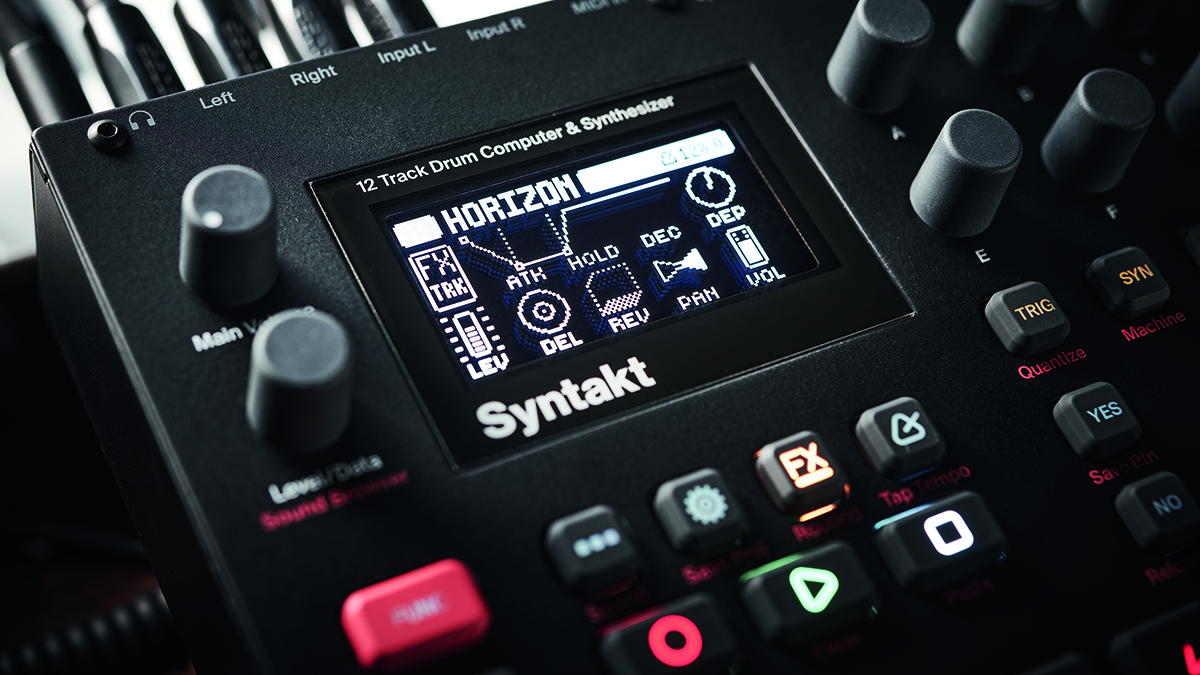
Specifications
Reasons to buy
Reasons to avoid
Drum machines purely based on synthesis can often be less versatile than their sample-powered counterparts, due to the inherent limitations of creating each sound from scratch. That’s not something that can be said of Elektron’s Syntakt.
By combining two distinct synthesis approaches – classic analogue synthesis and digital FM synthesis – Syntakt offers a vastly broader palette of sounds than many traditional drum synths. Of course, this also comes equipped with one of Elektron’s distinctively deep, if occasionally unwieldy, sequencers, which is capable of deep automation programming, probability sequencing, polymetric patterns, micro-timings and much more.
While the sample-based Digitakt is still a little more versatile overall, if you’re looking for electronic beats with plenty of punch – plus basses, chords and FX on the side – Syntakt is one of the most inspiring machines on the market.
Read our full Elektron Syntakt review
Best high-end drum machine
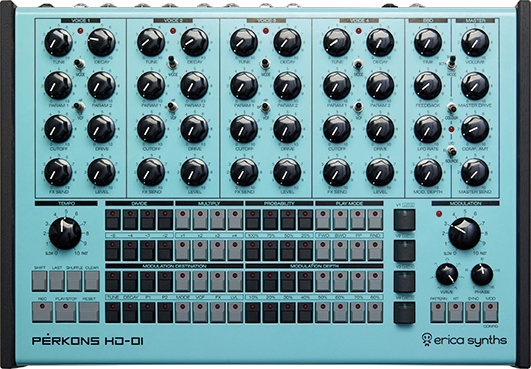
8. Erica Synths Perkons HD-01
Our expert review:
Specifications
Reasons to buy
Reasons to avoid
Perkons’ hybrid analogue/digital design functions as a best-of-both worlds approach, avoiding the flat tonality that sometimes comes with analogue drum machines, whilst maintaining the raw heft that comes with the best old-school machines. It does this by combining digital sound generators with analogue resonant filters and meaty overdrive for each voice.
One significant highlight of the Perkons’ workflow is its eight hands-on controls for each drum voice, allowing for lots of on-the-fly manipulation of sounds. Equally fun for live tweaking is the BBD effect send, which is capable of some great warped, rhythmic delays.
What arguably makes the Perkons most unique, however, is its four track sequencer, which allows for modulation and probability sequencing, per-step rolls and ratchets and easy polymetric patterns.
Best for experimentation
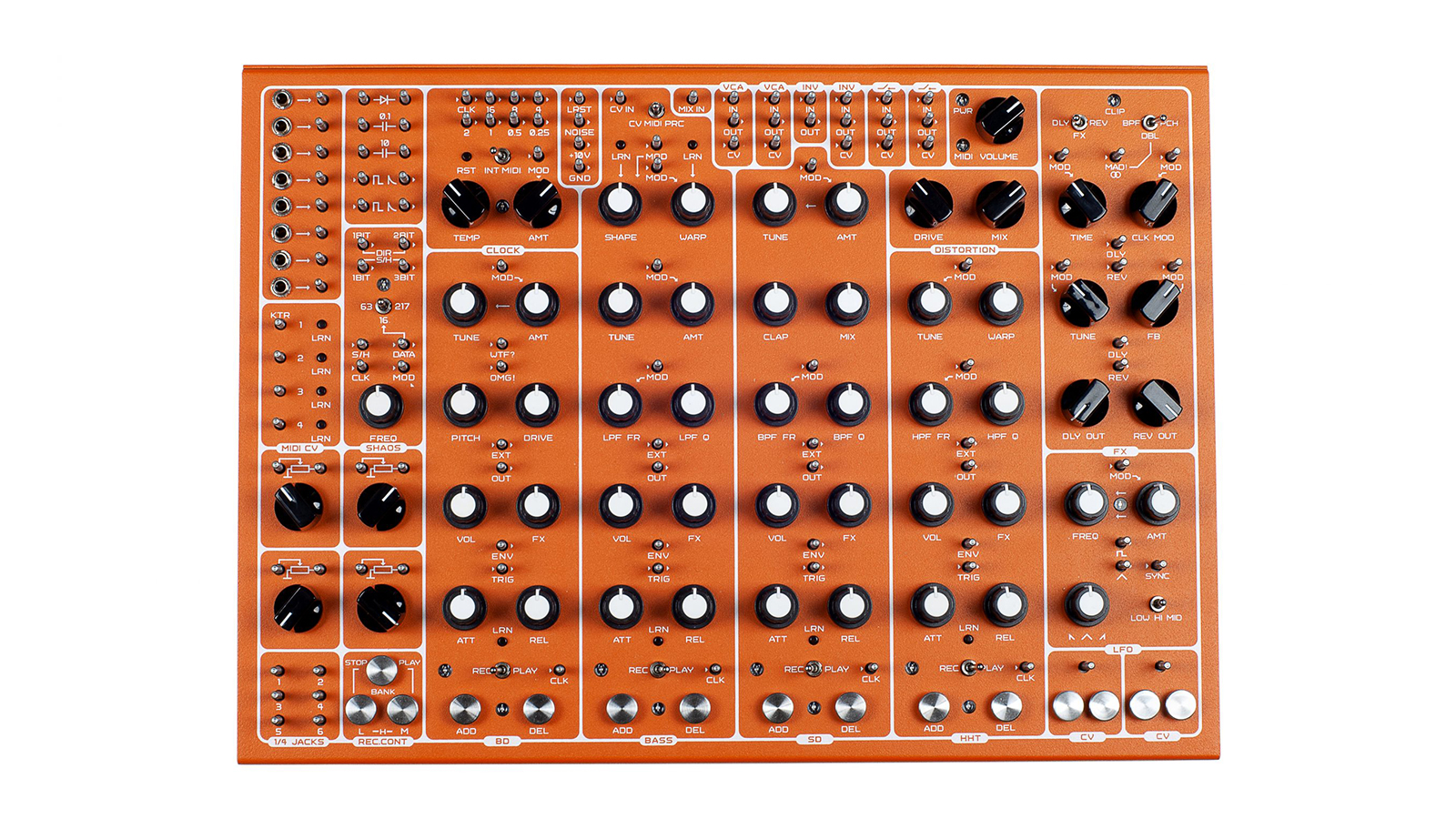
Specifications
Reasons to buy
Reasons to avoid
Unquestionably one of the most unique beat making tools of recent years. At a basic level, Pulsar-23 is a four-voice semi-modular percussion synth, with generators labelled Bass Drum, Bass, Snare Drum and Hi-Hat. The first two of these are more tonal, and it’s possible to play them melodically using MIDI and/or CV routings.
One of the most notable elements of the design, however, is the extensive range of pins spread across the interface. These are patch points for re-routing the various sound elements and utilities, which can be done either using the supplied crocodile clips or by placing fingers across pins to let your body itself conduct signals – with more expressive, less predictable results.
The Pulsar has recently been upgraded with a new bass drum generator as well as a change to screw-style patch pins, which brings the price down to a more accessible – if still fairly pricey – level.
Read our full Soma Labs Pulsar-23 review
Also tested
So, those are the drum machine we think tick the boxes for most use cases and budgets. However, the drum machine market is huge and we've tested most of the options you should be considering today. Below you'll find a handful more of our top-rated drum machines.
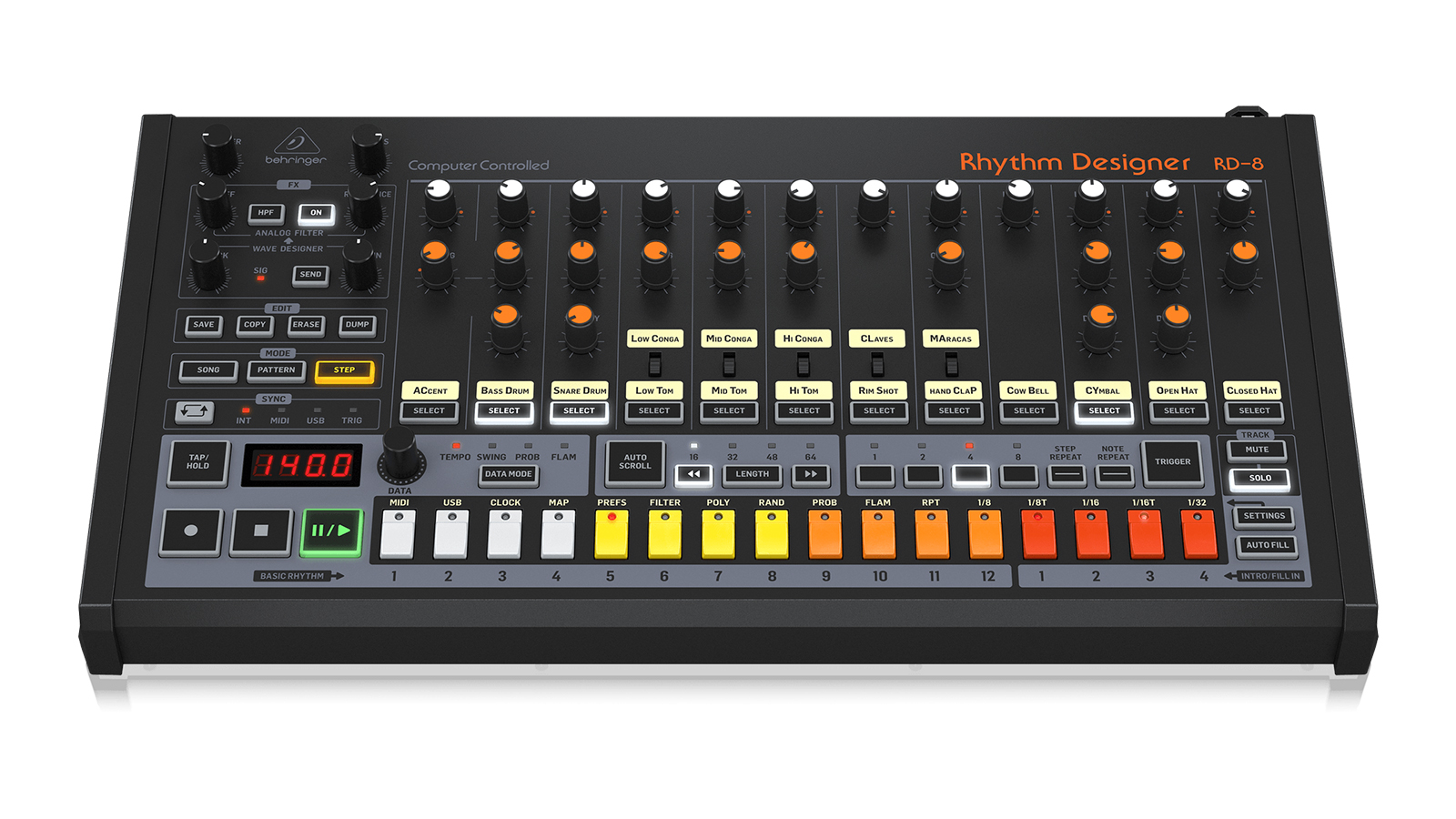
Behringer RD-8
Our expert review:
Specifications
Reasons to buy
Reasons to avoid
Roland has made it clear it has no intention of relaunching an analogue 808 so that leaves Behringer to give it a go with the RD-8. This does differ from the design of the 808, but where it matters, it’s bang on. The analogue sound engine is meaty and warm, and the kick, toms, rim and snares sound near enough indistinguishable from the original. There are slight differences in the tone and pitch of the cymbals, hats and cowbell, but we wouldn’t say they necessarily sound worse.
The RD-8 hardware is chunky too, which could be seen as impractical, but it lends it an authentic feeling of heft that’s missing from Roland’s Boutiques or, to an extent, the TR-8S. Its size leaves room for full jack outputs for every one of the 11 tracks, plus – one of our favourite features – a return input allowing for an external effects loop.
Updates to the sequencing side of things are generally pretty solid. Some changes are no-brainers, such as adding track selector buttons instead of the original’s dial, tuning for the kick, note repeat and introducing mute and solo features. Other areas, such as the revamped song system, probability steps, fills and flams, are welcome but aren’t quite as well implemented as on some rival drum machines.
Any slight misgivings aside, when taking into account sound, feel and workflow, this is the closest thing you’ll find to an original 808 on the market right now, which is remarkable given the price. That authenticity does come at a cost in some ways though – sonically, this is certainly one of the less versatile drum machines in our test.
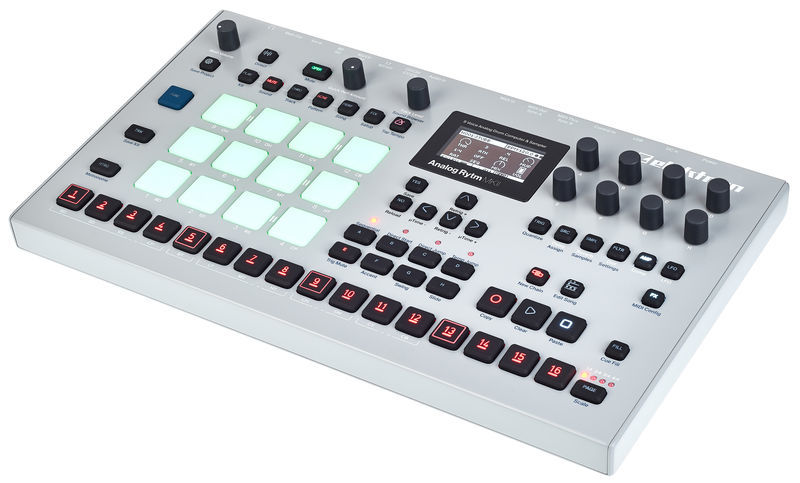
Specifications
Reasons to buy
Reasons to avoid
At the heart of the Rytm MkII you’ll find the same excellent eight-voice analogue/digital sound engine as found on the MKI, mated to the familiar 13-track sequencer. Each track is selected by pressing the track button and corresponding pad. The most obvious difference on the MKII’s front panel is that the old backlit pressure-sensitive rubber pads have been replaced by larger, softer versions so you can finally enjoy finger drumming on the Rytm (a huge improvement over the MKI).
As before, each pad/track can contain one of nine ‘machines’, which are self-contained synth engines dedicated to making a particular type of drum sound. The MKII sounds just like the MKI, which is no bad thing. There’s plenty of low-end extension, punch in the mids and rounded, classy high end. The Rytm has been improved in all the right places: it's one of the very best drum machines and will keep you inspired for years.
Read our full Elektron Analog Rytm MkII review
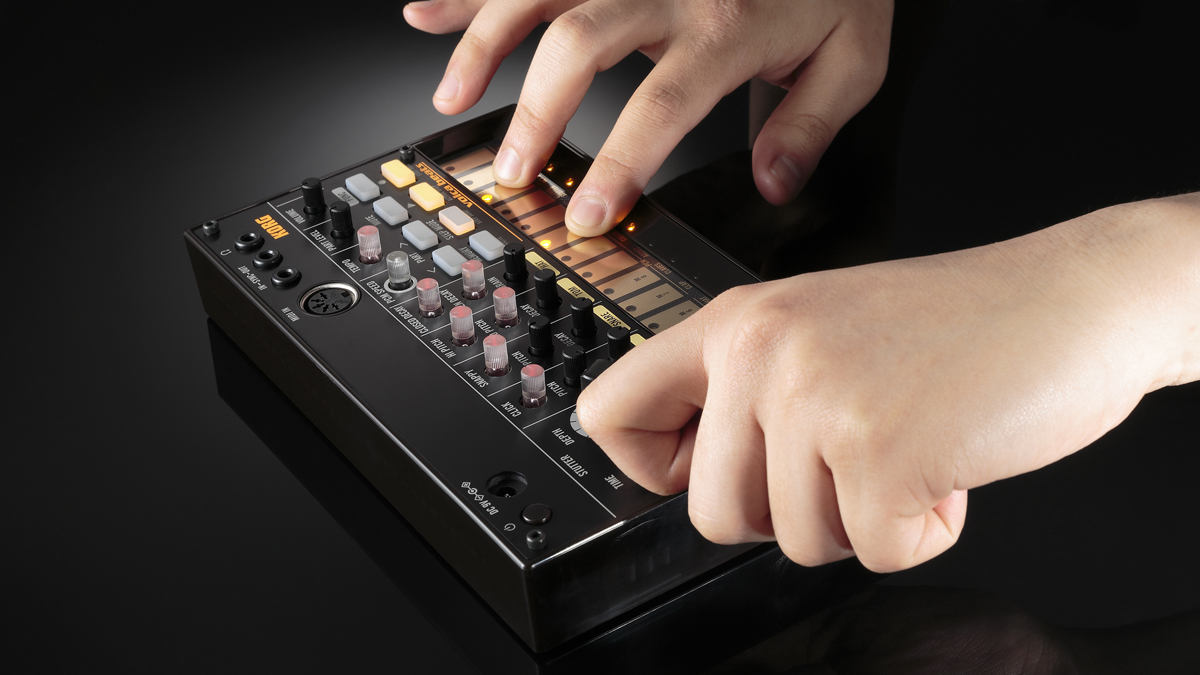
Specifications
Reasons to buy
Reasons to avoid
Taking sonic inspiration (we suspect) from Roland's classic TR-808, the Volca Beats has an analogue and PCM sound engine but offers digital control, meaning that knob tweaks and note info can be recorded into the built-in sequencer. Volca Beats has six analogue sounds (kicks, snare, hi-hats, and toms) and four PCM sounds (claves, agogo, clap, and crash cymbal).
The kick can be clicky or deep, the hats cut nicely, and the snare has a woody tone that can be further bolstered by layering a PCM clap or increasing the amount of 'snap'. As with the other Volcas, connectivity options are somewhat limited, but ultimately, the Volca Beats is about fun, and that's what you'll have when you use it. If you want quality analogue drum sounds on a budget, look no further.
Read our full Korg Volca Beats review
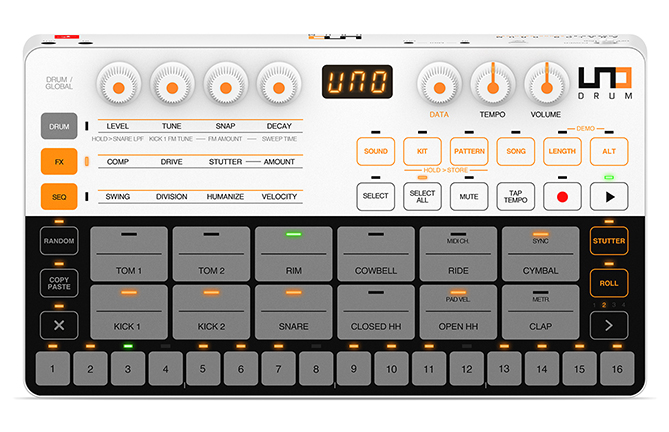
Specifications
Reasons to buy
Reasons to avoid
Representing IK Multimedia’s first foray into the world of analogue gear, UNO Drum is a hybrid analogue / sample playback machine with an impressive-sounding synth engine housed in a lightweight plastic casing. This makes it feel a little on the fragile side, raising the query of whether or not it could withstand the typical battering that more substantial devices are built to deal with.
That said, its six true analogue kick, snare clap and hi-hat sounds are authentically warm and rich-sounding, and are partnered with a choice of 54 PCM sounds lifted from IK’s SampleTank sample library. There’s 100 preset kits to explore, an extremely versatile and powerful sequencer with a 100-pattern memory, and some nice touches like the Stutter and Roll buttons to polish up your patterns, making the UNO Drum a fun piece of kit to play.
Read our full IK Multimedia UNO Drum review
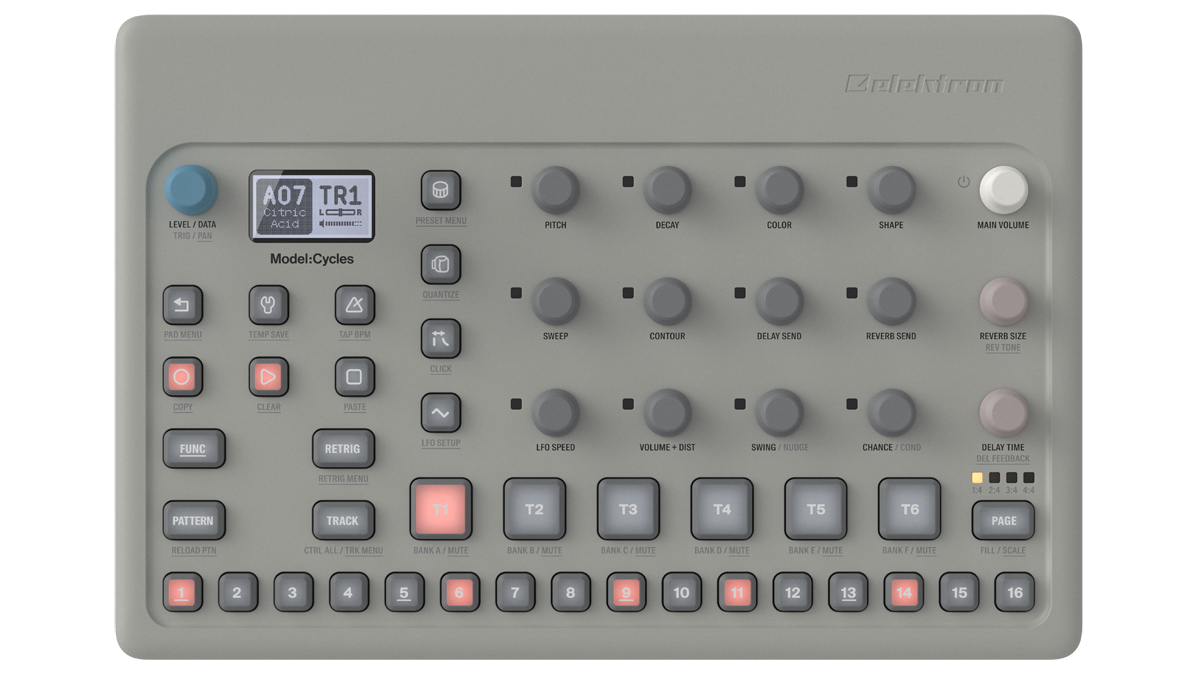
Specifications
Reasons to buy
Reasons to avoid
Elektron’s Model series made its debut with 2019’s Model:Samples - a sample-powered groovebox based around the engine from the brand’s Digitakt sampler. The Swedish firm has expanded the range with a second instrument, this time based around the sound engine of the Digitakt’s sibling instrument Digitone.
As with Digitone, Model:Cycles is based around a polyphonic FM (frequency modulation) synth engine paired with a 64-step sequencer. Unlike Model:Samples, which could be described as essentially the same as Digitakt with a few features removed, Model:Cycles isn’t simply a trimmed-down version of the Digitone. Despite using the same underlying four-operator engine, the way sound editing is presented means that the two are noticeably different in use.
The real highlight here is the sequencer. Each track has its own 64-step sequencer lane, the length and rate of which can be set individually. Elektron’s Parameter Locks feature allows for full per-step automation of all front-panel controls. This can even be used to change Machines mid-sequence, meaning a single track can be used to sequence multiple sounds.
Best of all is the inclusion of the Chance Parameter and Conditional Locks. These allow for deep control over the probability and conditions that dictate whether a hit will play on any sequencer step. It’s a wonderfully handy tool for adding variety and interest to otherwise static grooves and, with a dedicated front panel control, it’s at its most useable and intuitive here.
Read our full Elektron Model:Cycles review
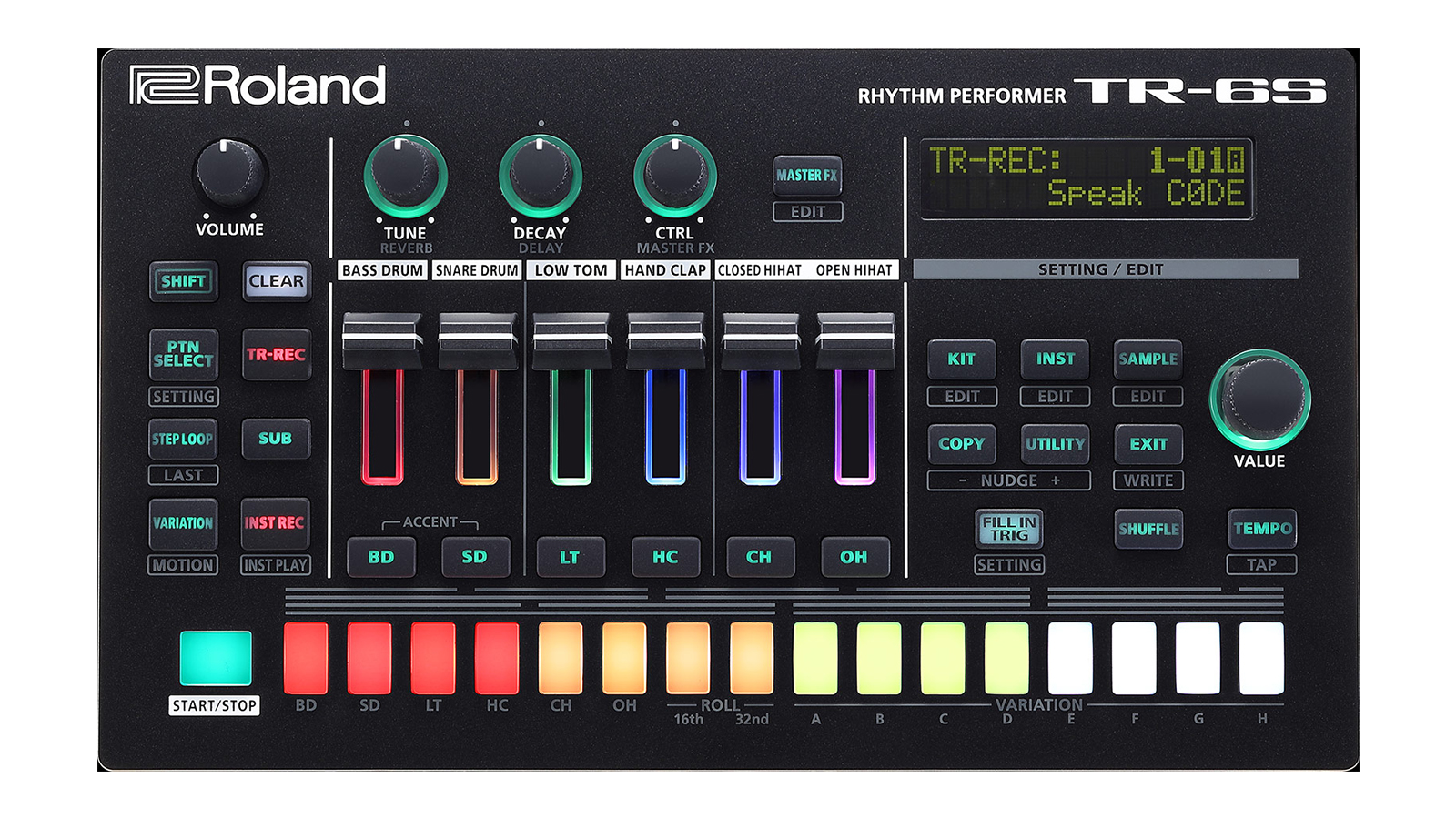
Specifications
Reasons to buy
Reasons to avoid
Best thought of as a more compact and affordable version of the TR-8S, the TR-6S Rhythm Performer is a six-track drum machine that can run on batteries. As well as the 808, 909, 707 and 606 kits that come included, there’s also an FM engine in here, and you can import your own samples via SD card. As such, there’s plenty of scope for creating hybrid kits.
The traditional TR step sequencer is included, but there’s also real-time recording and various other enhancements. You’ll find built-in effects, and the TR-6S can be used as a USB audio/MIDI interface.
While there are arguably more unique-sounding and characterful budget drum machines out there – Korg’s Volca Drum and Elektron’s Model:Cycles spring to mind – we can’t think of anything that offers this sort of versatility and flexibility this side of the $/£400 mark. As a first drum machine or a portable, convenient source of staple drum sounds, the TR-6S is very hard to beat.
Read the full Roland TR-6S review
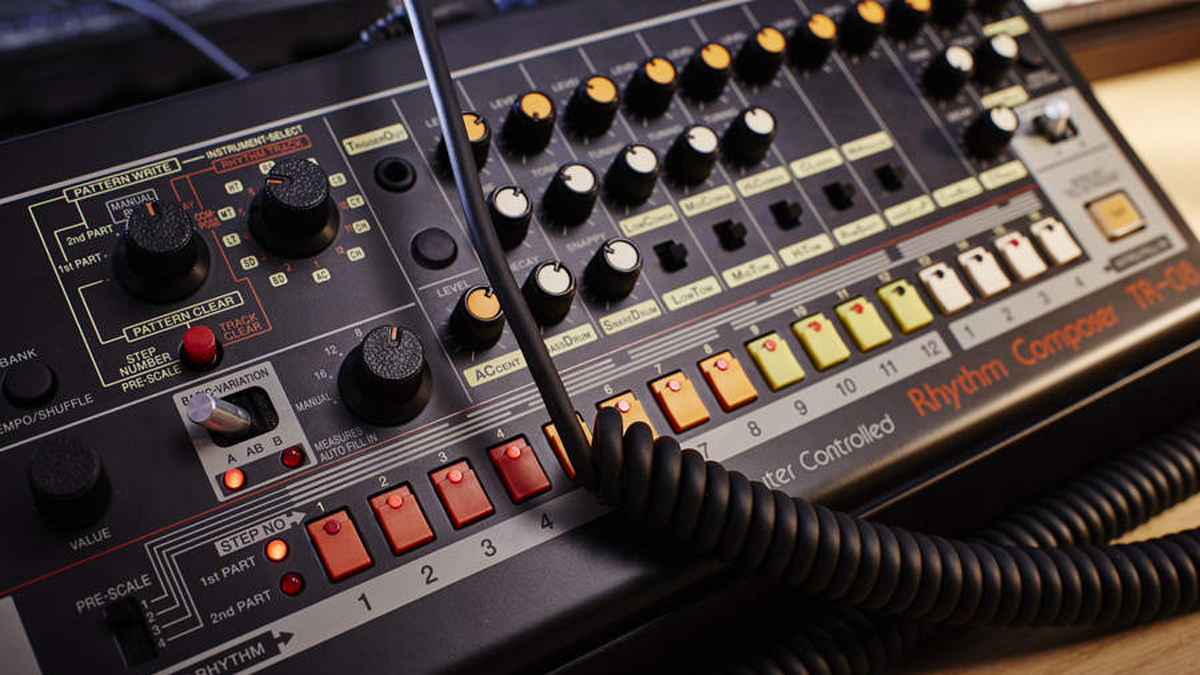
Specifications
Reasons to buy
Reasons to avoid
Part of Roland’s ‘Boutique’ range of digitally reimagined legacy hardware, it would be easy to focus on the ‘authenticity’ aspects of the TR-08, but it is much more of a 21st century machine than the original TR-808 in quite a few ways beyond its DSP-driven sound engine. Although the programming system follows broadly similar lines to the original, you now have the ability to add sub-step beats, create random patterns and dial in some swing - all useful features.
Compression can be applied individually to the Kick and Snare, whilst Tuning and Decay is available for some sounds (with the ability to select a long decay version of the Kick for those Miami bass lovers out there). This is a decent-sounding and affordable (relative to the original) digital resurrection of a classic beatbox, though we'd still like to have seen a few more editing options and multiple analogue outs.
Read our full Roland TR-08 review
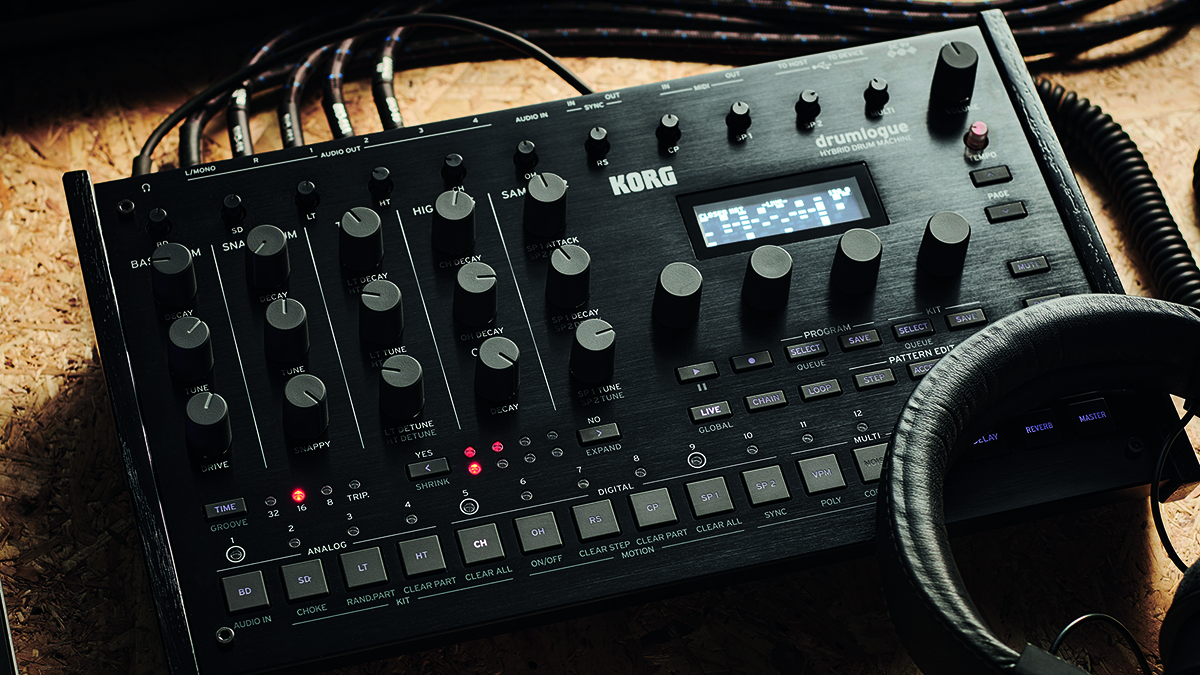
Specifications
Reasons to buy
Reasons to avoid
Released in late 2022, Korg’s Drumlogue joins the brand’s Minilogue and Monologue synths as another powerful yet affordable member of the Korg product family. Billed as a hybrid drum machine, the Drumlogue fuses analogue drum synthesis with digital oscillators and sample playback, making the instrument a suitable option for those looking to explore a variety of sonic flavours and production techniques.
A brief scan of the Drumlogue’s preset library reveals the machine as a stylistically versatile instrument capable of lending its hand to all manner of genres and sounds, from thumping, industrial techno to precise and glitchy IDM. Laying behind this versatility is the drum machine’s variegated approach to sound creation, which utilizes four highly tweakable analogue synth engines (bass, snare, low and high toms) and a digital synth module that handles open and closed hats, rim shots, and claps.
These work in tandem with the Multi-Engine, a multimode synth module that’s based on VPM (variable phase modulation) and noise generation, and can even host user-made sound generators devised using the Drumlogue’s open-source SDK. Alongside these methods of sound creation, the Drumlogue can handle user-loaded samples that can be layered on top of its synth engines.
Sounds produced by the Drumlogue can be manipulated and processed through a range of digital effects, with delay and reverb sends joined by a master effects section that hosts a filter, compressor, saturation and three-band EQ. Enterprising users can augment this selection with custom-designed effects created using the open-source SDK.
Connectivity abounds in the Drumlogue, outfitted as it is with six individual and routable outputs and a headphone output for good measure. These sit alongside an audio input, analogue sync input and output, MIDI in/out and two USB ports, meaning the drum machine will play nice with any and all external gear you may want to pair it with.
All in all, there’s plenty of good things to say about the Drumlogue, and we’d recommend it to any aspiring beatmaker searching for a mid-range drum machine that stands a cut above budget beat-boxes in terms of functionality and versatility without coming close to breaking four figures in price.
Read our full Korg Drumlogue review
Buying advice
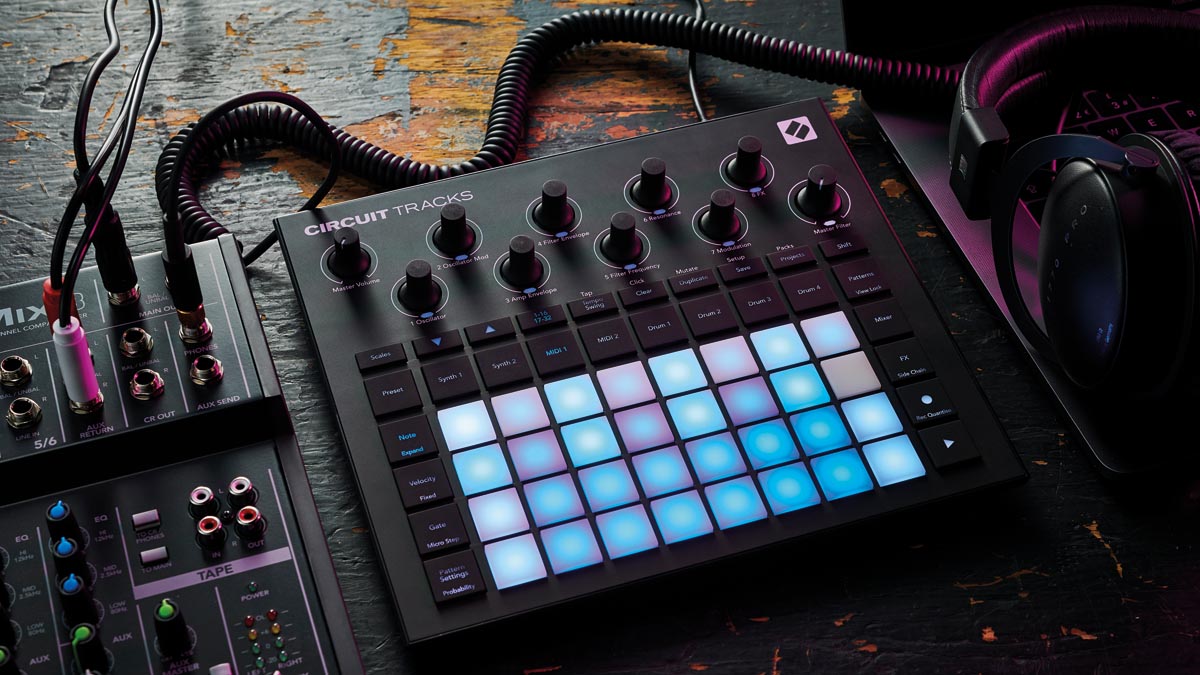
How to choose the best drum machine for you
MusicRadar's got your back
Price is always going to be a significant factor when you choose a drum machine, but it should not be the only consideration. The sound you are after should also be a top priority as this can vary enormously between models, from proper analogue synth circuitry to generate drum tones, through a more flexible combination of both analogue synthesis and digital samples, to totally customisable models that let you load in your own samples by means of an SD card or similar. You also need to decide whether you need portability or are happy with a heavier, more static model that will stay in your studio.
Other factors worth considering include…
- Audio outputs: you might need to process individual drum sounds through a mixing desk or multi-channel audio interface, so consider how many outputs your drum machine has. Ideally you'll need a separate output for each sound which can be sent to its own channel and treated with its own effects. If a unit only has a single stereo output, you can get by but you’ll need to use a work around, perhaps making multiple passes with individual sounds running in solo, transferring each sound, one by one to a DAW.
- Performance workflow: if you want to use a drum machine to perform with on stage, you'll want it to have a user-friendly interface and easy performance workflow. You won't want to be fiddling with too much menu diving and you'll also require decent-sized pads to navigate to and perform with, rather than fiddly buttons. Chaining individual patterns together into full tunes is a must if you want to program your machine to handle complete song duties while you play over the top, or even to create different patterns while playing live.
- MIDI / Sync: our focus here is on standalone machines, but any degree of connectivity is going to be useful at some point – you will want to integrate your beats with other hardware and/or your DAW – so ensure your chosen machine has MIDI at least, and the ability to sync to an external clock source.
How we choose products
Here at MusicRadar, we are experts in our field, with many years of playing, creating and product testing between us. We live and breathe everything music gear related, and we draw on this knowledge and experience of using products in live, recording and rehearsal scenarios when selecting the products for our guides.
When choosing what we believe to be the best drum machines available right now, we combine our hands-on experience, user reviews and testimonies and engage in lengthy discussions with our editorial colleagues to reach a consensus about the top products in any given category.
First and foremost, we are musicians, and we want other players to find the right product for them. So we take into careful consideration everything from budget to feature set, ease of use and durability to come up with a list of what we can safely say are the best drum machines on the market right now.
Find out more about how we test music gear and services at MusicRadar.
Read more:
- Best MIDI pad controllers for beatmaking and sequencing
- Best MIDI keyboards for Mac, PC, iPhone and iPad
- Best synthesizers: top keyboards, modules and semi-modular synths
- Best studio headphones: great cans for music production
- Our pick of the best Eurorack modules
Get the MusicRadar Newsletter
Want all the hottest music and gear news, reviews, deals, features and more, direct to your inbox? Sign up here.
I'm the Managing Editor of Music Technology at MusicRadar and former Editor-in-Chief of Future Music, Computer Music and Electronic Musician. I've been messing around with music tech in various forms for over two decades. I've also spent the last 10 years forgetting how to play guitar. Find me in the chillout room at raves complaining that it's past my bedtime.